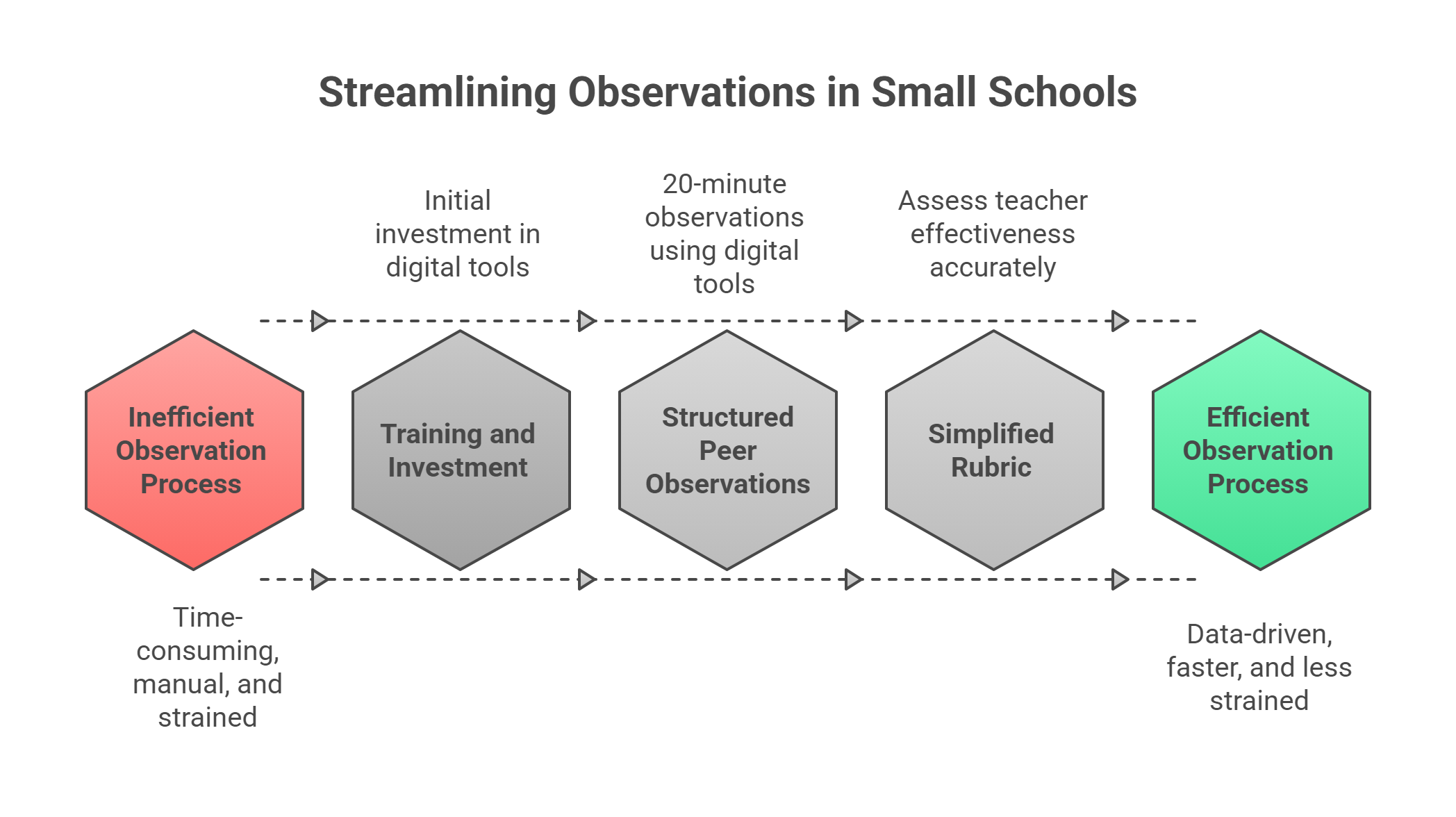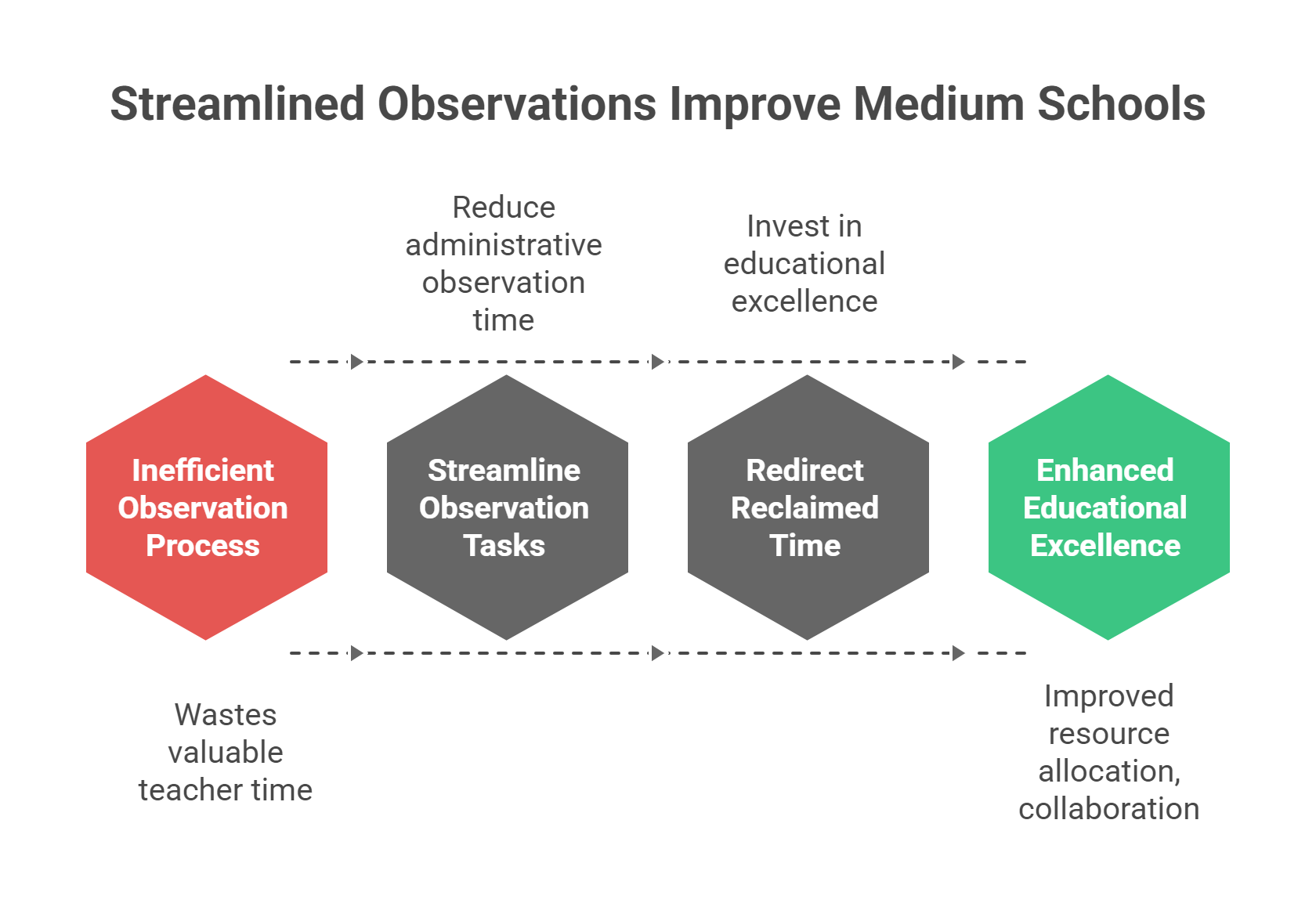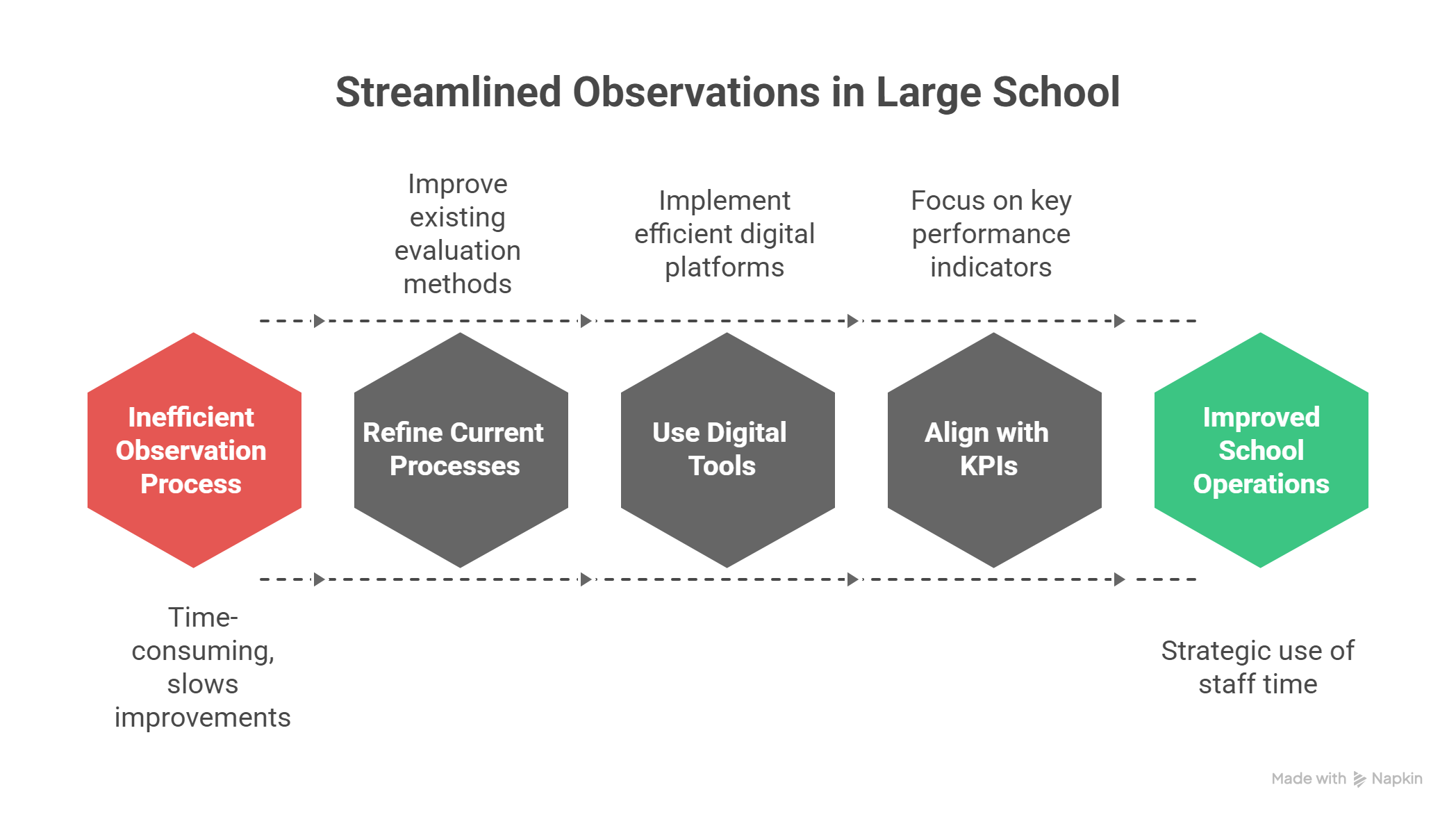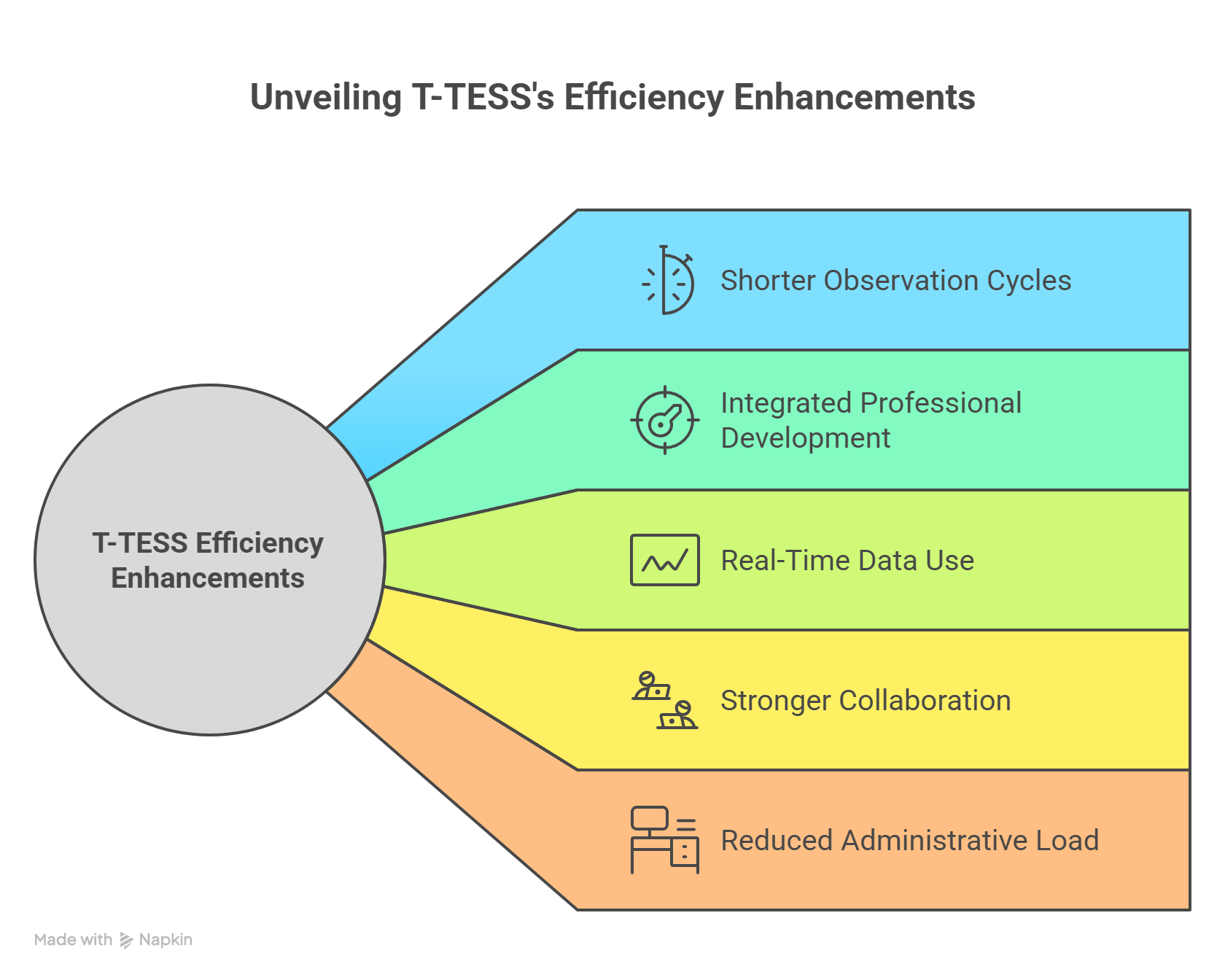Despite years of reform, most teacher evaluations still lack meaning. A national study found that 97 percent of teachers were rated “excellent,” raising concerns about effectiveness and accountability. These flawed systems waste time, reduce customer satisfaction, and strain school resources. So, how much time and money can you save with streamlined observations? This article explores how improving evaluation processes increases customer satisfaction, strengthens cash flow, and allows better planning without depending on expensive project management software.
Key Takeaways
- Streamlined observation processes save substantial time and money for schools of all sizes, with small, medium, and large schools saving 39, 78, and 130 hours annually, respectively.
- Implementing systems like T-TESS enhances efficiency by reducing observation time and automating feedback delivery, ultimately improving educational outcomes and reducing administrative burdens.
How Much Time Can Schools Save?
Time savings from streamlined observation processes vary by school size. Let’s break down the impact for small, medium, and large schools.
Small Schools

For small schools with limited staff and resources, streamlining observation processes is critical to improving efficiency and educational outcomes.
One large-scale intervention showed how structured peer observations, supported by digital tools, can drive meaningful change. In this program, secondary school teachers used RANDA TOWER software on tablets to conduct 20-minute classroom observations over two years. The initiative required training and upfront investment, but it helped schools improve the quality of feedback, reduce observation time, and strengthen collaboration.
Research supports these gains. One study found that just 20 minutes of classroom footage, paired with a simplified rubric, enabled observers to assess teacher effectiveness accurately. In smaller schools with fewer staff, this reduction in observation time directly impacts efficiency.
Additionally, schools that use digital platforms to conduct and analyze evaluations experience less manual work and faster turnarounds. This not only supports data-driven decisions but also improves the quality of feedback and reduces administrative strain.
Video-based observations also reduce scheduling issues, saving valuable hours that would otherwise be spent on repeated in-person sessions. Streamlining current processes allows schools to focus on professional development and classroom support, rather than time-consuming tasks.
Ultimately, reducing observation time helps schools meet key performance indicators by making better use of limited resources. When schools improve their internal efficiency, they are better positioned to respond to customer inquiries, align with strategic goals, and invest more in what matters most: student success.
Medium Schools

Medium-sized schools, typically employing about 60 teachers and serving 500 or more students, benefit significantly from streamlined observation processes. According to NCES data from the 2021–22 school year, around 39 percent of public schools fall into this size range, making them a key demographic for scalable improvements.
With improved evaluation systems, these schools can save an estimated 78 hours annually, equivalent to nearly 10 full workdays. This reclaimed time creates opportunities to improve resource allocation, support instructional leadership, and strengthen school-wide collaboration.
More importantly, time saved from administrative observation tasks can be redirected toward initiatives that enhance educational excellence. Schools can invest more effort in creating a dynamic learning environment, expanding professional development, and refining data practices that directly support student success.
Given their scale and the demands of serving diverse student populations, medium-sized schools are especially well-positioned to benefit from process improvements that boost efficiency and instructional quality.
Large Schools

Large schools, often employing around 100 teachers, stand to gain the most from streamlined observation processes. With larger staff and more complex demands, these schools can save approximately 130 hours annually, equal to more than 16 full workdays. These time savings significantly improve business operations, reduce strain on leadership teams, and allow for more strategic use of staff time.
According to the Brookings Institute, the national average student-teacher ratio is 15.3 to 1. In some states, such as California, this ratio increases to 22 to 1, meaning teachers manage larger classrooms and face greater instructional demands. Without streamlined systems, traditional evaluations consume valuable time and slow school-wide improvements.
By refining current processes and using efficient digital tools, large schools can better align their efforts with key performance indicators and instructional goals. Time that would otherwise be spent on paperwork and scheduling can be redirected toward data-driven decisions, instructional analysis, and new strategies that support student achievement.
These schools are also well-positioned to strengthen internal processes, enhance teacher collaboration, and respond more effectively to customer inquiries from parents, staff, and district leadership. Streamlining observation systems is not only about saving time. It is a strategic way for large schools to boost performance, increase productivity, and improve long-term outcomes.
Curious how streamlined observations could look in your own building?
What Is the Financial Impact and ROI?
Streamlined observation systems deliver strong financial returns by reducing costs associated with training, evaluation time, and administrative processing. Studies consistently show that improved efficiency in observation design and data use translates into measurable savings that strengthen business operations and overall school performance.
The RATE (Rapid Assessment of Teacher Effectiveness) system demonstrated that effective evaluations can be conducted in just 20 minutes of focused observation using a six-item rubric, compared to traditional models that require hours of observation and 60 or more criteria. This reduction in observation length and complexity lowers labor costs and training demands, improving cash flow and helping schools achieve better key performance indicators.
Traditional observation systems, such as those implemented in Tennessee during the 2011–2012 academic year, required nearly 300,000 classroom evaluations. Research found that this approach consumed substantial resources, highlighting the need for cost-effective, scalable models. When schools simplify evaluation frameworks, they not only save valuable staff time but also reduce the financial burden of repetitive administrative work.
Modern observation tools, including digital and video-based platforms, further improve return on investment by promoting data-driven decisions. These systems help administrators quickly identify trends, reduce redundancy, and allocate funding where it matters most, enhancing instructional quality and long-term sustainability.
See what other schools have saved by simplifying their evaluations.
Estimated Cost Savings by School Size
Here’s a quick look at how much schools can save each year by streamlining observations.
| School Size | Estimated Annual Savings | Key Benefit |
|---|---|---|
| Small (≈30 teachers) | $1,781 | Improved resource allocation and reduced administrative costs |
| Medium (≈60 teachers) | $3,563 | More efficient budgeting and professional development investment |
| Large (≈100 teachers) | $5,938 | Significant operational savings and enhanced organizational capacity |
A Note on Estimates: These financial estimates are based on modeled projections using average educator salaries and reported time savings from studies on observation efficiency, including RATE. Actual results may vary depending on staffing, implementation scale, and existing systems. The figures are intended to illustrate potential financial impact and return on investment, not guaranteed outcomes.
How Does T-TESS Improve Efficiency for Texas Educators?

Unlike outdated systems, T-TESS incorporates streamlined data practices, ongoing feedback, and structured training to help schools manage evaluations with less spending and greater return on investment. The system includes multiple components: classroom observation, professional goal-setting, and Student Learning Objectives (SLOs), all tailored to promote continuous improvement, collaboration, and long-term instructional efficiency.
Below are the core ways the system drives measurable benefits and improved use of time and resources:
- Shorter Observation Cycles: Formal classroom observations now take just 90 minutes, compared to the traditional 135 minutes. This saves up to 45 minutes per evaluation, allowing leaders to spend less time on paperwork and more time on coaching and feedback.
- Integrated Professional Development: T-TESS links classroom observations with individual growth plans. This ensures that each teacher receives actionable feedback and customized training that supports their specific goals and student needs.
- Real-Time Data Use: Educators and appraisers can review observation notes, student progress, and instructional trends in real time. This enables data-driven conversations and more intelligent decisions about curriculum, interventions, and resource allocation.
- Stronger Collaboration: Teachers and appraisers engage in regular feedback cycles, creating time for reflection, discussion, and strategic planning. These touchpoints allow teams to learn from one another and foster a shared vision of instructional excellence.
- Reduced Administrative Load: By using digital platforms and well-defined processes, T-TESS minimizes the need for manual documentation, excessive reporting, and repeated evaluations. This lightens the load on employees, enabling staff to focus on coaching, support, and leadership development.
What Are the Multi-Year Benefits?
The value of streamlined processes extends far beyond a single school year. When schools adopt systems that reduce repetitive tasks and improve the observation workflow, they set the stage for continuous improvement and long-term success. The cumulative effect of saved time and resources leads to a more efficient operation, where both educators and administrators can focus more on instruction and less on administrative burden.
Over time, these savings allow schools to streamline operations, reinvest in instructional priorities, and improve outcomes tied to key metrics such as teacher effectiveness, student achievement, and staff retention.
Three-Year Savings for Medium Schools
A medium-sized school with 60 teachers can save approximately 234 hours over three years through streamlined processes. These recovered hours support a more efficient workflow, enabling school leaders to reallocate time to professional development, collaborative planning, and targeted student interventions.
Instead of spending valuable time on manual evaluations and paperwork, staff can focus on strategic initiatives that drive continuous improvement year after year.
Five-Year Savings for Medium Schools
Over five years, the same school could save 390 hours, translating into an estimated financial impact of $17,813. These long-term cost reductions give administrators the flexibility to plan for future needs, expand instructional programs, and allocate resources more effectively.
By continuing to streamline operations and eliminate inefficiencies, schools position themselves for sustainable success. This forward-thinking approach supports staff development, encourages innovation, and ensures that time is spent on high-impact activities rather than repetitive tasks.
What Is the Impact at a District Level?
When schools improve their observation systems, the benefits extend well beyond individual classrooms. At the district level, these improvements multiply, helping save time, reduce administrative strain, and make teacher evaluations more focused and effective. Streamlined processes support district leaders in making smarter, data-informed decisions that foster instructional growth across multiple campuses.
This is not only about saving hours. It is about helping educators, principals, and leadership teams spend more time on meaningful priorities such as coaching teachers, supporting students, and guiding school improvement efforts.
Total Hours Saved
Consider a district with 10 schools, each with around 60 teachers. By adopting more efficient observation practices, this district could save up to 780 hours each year. That equals nearly 98 full workdays that can be redirected toward professional development, curriculum planning, or leadership support.
Lang (2019) observed similar outcomes in a rural Maine district. Teachers using video tools like SWIVL to conduct self-observations and hold targeted follow-up conversations with administrators reported more efficient professional growth discussions. The study highlighted how these tools reduced administrative workload while promoting professional autonomy, leading to more efficient districtwide evaluation practices.
Eliminating repetitive tasks and simplifying the feedback process allows districts to shift from reactive oversight to proactive instructional leadership.
Value of Saved Administrator Time
Time savings at the leadership level also carry real financial weight. In the same 10-school district, the estimated value of saved administrator time is approximately $35,625 per year. These recovered funds can be reinvested in teacher training, instructional coaching, or learning tools that directly benefit students and staff.
Research by Milanowski (2011), which focused on large districts such as New York City and Chicago, found that moving from checklist-based evaluations to more structured, professional observation models improved both accuracy and efficiency. The implication is clear: upgrading the system can lead to better outcomes with fewer wasted resources.
What Is the Opportunity Cost of Saved Time?
The opportunity cost of reinvesting saved time into high-impact activities is a crucial consideration for schools. By redirecting saved hours towards productive engagements, schools can achieve more meaningful work and improve educational outcomes through effective decision-making.
This section will explore how the saved time can be used for parent conferences, teacher coaching sessions, and classroom walkthroughs, highlighting the benefits for teachers and students.
Parent Conferences
Medium schools save 78 hours annually through streamlined observation processes. This saved time enables approximately 156 parent conferences annually, improving communication and collaboration between schools and families.
By ensuring that parents and teachers are on the same page, schools can create a more supportive and engaged educational environment.
Teacher Coaching Sessions
The 78 hours saved annually by medium schools can also be used to conduct up to 104 additional coaching sessions for teachers. These sessions are crucial for promoting professional development and enhancing teacher effectiveness.
Focusing on training and team development ensures educators are well-supported and continuously improving their instructional practices. This increased focus on professional growth contributes to a more dynamic and effective teaching environment.
Classroom Walkthroughs
Time saved from streamlined observation processes can also be directed towards conducting 468 additional classroom walkthroughs annually.
These walkthroughs are essential for identifying areas for improvement, eliminating redundant steps, and providing real-time feedback to teachers.
More frequent classroom observations significantly enhance instructional quality and oversight. This proactive approach ensures that teaching practices are continuously refined and aligned with educational goals.
What Are the Additional Benefits Beyond Time Savings?
Beyond the obvious time and cost savings, streamlined observation systems offer numerous additional benefits.
Let’s explore how these systems improve feedback delivery, enhance teacher development, and reduce administrative tasks.
Improved Feedback Delivery
Streamlined observation methods provide quicker, more actionable feedback that educators can implement immediately. Such systems facilitate real-time feedback, enabling teachers to make prompt adjustments to their teaching methods. This improved feedback delivery enhances teaching effectiveness and positively impacts student learning outcomes.
Continuous improvement fosters efficient workflows and enhances overall educational quality, thereby increasing productivity.
Enhanced Teacher Development
Regular observations contribute to ongoing professional development by identifying areas for growth and providing targeted support. Frequent observations create opportunities to identify targeted professional growth by highlighting specific strengths and areas for improvement.
With consistent feedback, teachers can engage in more meaningful work, leading to increased productivity and a competitive edge for the school. This focus on continuous improvement ensures that educators are well-equipped to meet their students’ evolving needs.
Reduced Administrative Burden
Automated data collection through streamlined systems significantly reduces the time educators spend on administrative tasks, including repetitive tasks. For example:
- The T-TESS evaluation cycles reduce observation time from 135 to 90 minutes, saving 45 minutes per formal observation.
- Small schools save 39 hours annually through these streamlined processes.
- Medium schools save 78 hours annually.
- Large schools save 130 hours annually.
These time savings translate into significant cost savings and improved efficiency, allowing educators to focus more on instruction rather than administrative duties.
What Should You Consider Before Implementation?
Rolling out a streamlined observation system is more than a tech upgrade. It represents a strategic shift in how schools manage time, support growth, and improve instruction. To implement effectively, schools must evaluate their current processes, plan training, and engage staff meaningfully.
Below are three essential areas to address before launching a new observation system.
Start by Training Observers for Consistency
To maintain reliability in the evaluation process, well-trained observers are essential. Without clear guidelines and thorough preparation, even strong systems can produce inconsistent or error-prone results.
Investing in focused observer training helps create a shared standard for what effective teaching looks like. This builds evaluator confidence and ensures the feedback process is both fair and efficient.
Address Technology Skills Across the Team
Once your observers are trained, the next step is to ensure all staff members are comfortable with the tools they will be using. Technology can improve efficiency, but only if educators are confident using it.
Because tech proficiency varies across individuals, schools should identify where additional support is needed. Offering customized training helps reduce frustration, improve adoption, and keep the daily workflow running smoothly.
Gain Staff Buy-In Early and Often
Even with the best tools in place, success depends on staff support. Educators are more likely to embrace new systems when they understand the benefits and feel included in the process.
Start by explaining how the new system will reduce repetitive tasks, support more meaningful work, and give teachers more time to focus on instruction. Involve them in decision-making, invite questions, and build a collaborative culture around the change.
Summary
Streamlined observation systems offer more than just time and cost savings. They help schools operate more efficiently, reduce repetitive tasks, and create more time for meaningful professional growth.
From small campuses to large districts, the results are consistent. Schools save hundreds of hours, strengthen feedback systems, and improve instructional quality over time.
With tools like T-TESS, Student Learning Objectives, and modern observation platforms, educators can focus less on paperwork and more on impact. Over multiple years, these changes have led to better planning, smarter resource use, and stronger outcomes for both teachers and students.
Instead of managing outdated processes, schools can adopt systems built for continuous improvement, making observation easier, faster, and more actionable at every level.
At Education Walkthrough, we help schools simplify observations, save time, and support teacher growth. Try our Classroom Walkthrough Software free and see how easy it is to reduce admin time, deliver faster feedback, and drive continuous improvement across your school or district.
Start your free trial of Education Walkthrough
Frequently Asked Questions
How much time can small schools save annually with streamlined observations?
Small schools with 30 teachers can save approximately 39 hours annually through streamlined observations, which translates to nearly five full workdays. This significant time savings can enhance overall efficiency and resource management.
What are the financial benefits for medium schools using streamlined observation systems?
Medium schools can save around $3,563 annually by utilizing streamlined observation systems, enhancing both financial efficiency and operational effectiveness. This cost reduction allows for reallocation of resources to improve educational quality.
How does the T-TESS system improve observation efficiency?
The T-TESS system improves observation efficiency by reducing formal observation cycles from 135 minutes to 90 minutes, thus saving 45 minutes per observation. This streamlined process allows for more effective use of time during evaluations.
What is the annual value of saved administrator time for a district with 10 schools?
The annual value of saved administrator time for a district with 10 schools is approximately $35,625. This significant savings highlights the importance of efficient administration within educational institutions.
How can streamlined observation systems enhance teacher development?
Streamlined observation systems enhance teacher development by delivering regular feedback that pinpoints areas for improvement and offers tailored support, fostering ongoing professional growth.



